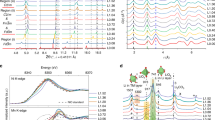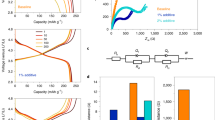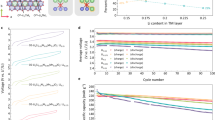Abstract
Ion exchange is a powerful method to access metastable materials with advanced functionalities for energy storage applications. However, high concentrations and unfavourably large excesses of lithium are always used for synthesizing lithium cathodes from parent sodium material, and the reaction pathways remain elusive. Here, using layered oxides as model materials, we demonstrate that vacancy level and its corresponding lithium preference are critical in determining the accessible and inaccessible ion exchange pathways. Taking advantage of the strong lithium preference at the right vacancy level, we establish predictive compositional and structural evolution at extremely dilute and low excess lithium based on the phase equilibrium between Li0.94CoO2 and Na0.48CoO2. Such phase separation behaviour is general in both surface reaction-limited and diffusion-limited exchange conditions and is accomplished with the charge redistribution on transition metals. Guided by this understanding, we demonstrate the synthesis of NayCoO2 from the parent LixCoO2 and the synthesis of Li0.94CoO2 from NayCoO2 at 1–1,000 Li/Na (molar ratio) with an electrochemical assisted ion exchange method by mitigating the kinetic barriers. Our study opens new opportunities for ion exchange in predictive synthesis and separation applications.
This is a preview of subscription content, access via your institution
Access options
Access Nature and 54 other Nature Portfolio journals
Get Nature+, our best-value online-access subscription
$29.99 / 30 days
cancel any time
Subscribe to this journal
Receive 12 print issues and online access
$259.00 per year
only $21.58 per issue
Buy this article
- Purchase on Springer Link
- Instant access to full article PDF
Prices may be subject to local taxes which are calculated during checkout





Similar content being viewed by others
Data availability
The authors declare that all relevant data are included in the paper and Supplementary Information files and are available from the corresponding author upon reasonable request.
References
Gwon, H. et al. Ion-exchange mechanism of layered transition-metal oxides: case study of LiNi0.5Mn0.5O2. Inorg. Chem. 53, 8083–8087 (2014).
Park, Y.-U. et al. In situ tracking kinetic pathways of Li+/Na+ substitution during ion-exchange synthesis of LixNa1.5–xVOPO4F0.5. J. Am. Chem. Soc. 139, 12504–12516 (2017).
Kamysbayev, V. et al. Covalent surface modifications and superconductivity of two-dimensional metal carbide MXenes. Science 369, 979–983 (2020).
Son, D. H., Hughes, S. M., Yin, Y. & Alivisatos, A. P. Cation exchange reactions in ionic nanocrystals. Science https://doi.org/10.1126/science.1103755 (2004).
Beberwyck, B. J. & Alivisatos, A. P. Ion exchange synthesis of III–V nanocrystals. J. Am. Chem. Soc. 134, 19977–19980 (2012).
Li, Z., Saruyama, M., Asaka, T., Tatetsu, Y. & Teranishi, T. Determinants of crystal structure transformation of ionic nanocrystals in cation exchange reactions. Science 373, 332–337 (2021).
Zou, Y.-C. et al. Ion exchange in atomically thin clays and micas. Nat. Mater. 20, 1677–1682 (2021).
Whittaker, M. L., Lammers, L. N., Carrero, S., Gilbert, B. & Banfield, J. F. Ion exchange selectivity in clay is controlled by nanoscale chemical–mechanical coupling. Proc. Natl Acad. Sci. USA 116, 22052–22057 (2019).
Delmas, C., Braconnier, J.-J. & Hagenmuller, P. A new variety of LiCoO2 with an unusual oxygen packing obtained by exchange reaction. Mater. Res. Bull. 17, 117–123 (1982).
Carlier, D. et al. On the metastable O2-type LiCoO2. Solid State Ion. 144, 263–276 (2001).
Tournadre, F. et al. On the mechanism of the P2–Na0.70CoO2→O2–LiCoO2 exchange reaction—part I: proposition of a model to describe the P2–O2 transition. J. Solid State Chem. 177, 2790–2802 (2004).
Tournadre, F., Croguennec, L., Willmann, P. & Delmas, C. On the mechanism of the P2–Na0.70CoO2→O2–LiCoO2 exchange reaction—part II: an in situ X-ray diffraction study. J. Solid State Chem. 177, 2803–2809 (2004).
Delmas, C., Fouassier, C. & Hagenmuller, P. Structural classification and properties of the layered oxides. Phys. B+C. 99, 81–85 (1980).
Capitaine, F., Gravereau, P. & Delmas, C. A new variety of LiMnO2 with a layered structure. Solid State Ion. 89, 197–202 (1996).
Armstrong, A. R. & Bruce, P. G. Synthesis of layered LiMnO2 as an electrode for rechargeable lithium batteries. Nature 381, 499–500 (1996).
Paulsen, J. M., Donaberger, R. A. & Dahn, J. R. Layered T2-, O6-, O2-, and P2-type A2/3[M′2+1/3M4+2/3]O2 bronzes, A = Li, Na; M‘ = Ni, Mg; M = Mn, Ti. Chem. Mater. 12, 2257–2267 (2000).
Paulsen, J. M. & Dahn, J. R. O2‐type Li2/3[Ni1/3Mn2/3]O2: a new layered cathode material for rechargeable lithium batteries ii. structure, composition, and properties. J. Electrochem. Soc. 147, 2478 (2000).
Paulsen, J. M., Thomas, C. L. & Dahn, J. R. Layered Li‐Mn‐oxide with the O2 structure: a cathode material for Li‐ion cells which does not convert to spinel. J. Electrochem. Soc. 146, 3560–3565 (1999).
Paulsen, J. M. & Dahn, J. R. Studies of the layered manganese bronzes, Na2/3[Mn1−xMx]O2 with M=Co, Ni, Li, and Li2/3[Mn1−xMx]O2 prepared by ion-exchange. Solid State Ion. 126, 3–24 (1999).
Paulsen, J. M., Larcher, D. & Dahn, J. R. O2 structure Li2/3[Ni1/3Mn2/3]O2: a new layered cathode material for rechargeable lithium batteries III. Ion exchange. J. Electrochem. Soc. 147, 2862–2867 (2000).
Lu, Z., Donaberger, R. A., Thomas, C. L. & Dahn, J. R. T2 and O2 Li2/3[CoxNi1/3−x/2Mn2/3−x/2]O2 electrode materials. J. Electrochem. Soc. 149, A1083 (2002).
Lu, Z. & Dahn, J. R. The effect of Co substitution for Ni on the structure and electrochemical behavior of T2 and O2 structure Li2/3[CoxNi1/3−xMn2/3]O2. J. Electrochem. Soc. 148, A237 (2001).
Kang, K., Meng, Y. S., Bréger, J., Grey, C. P. & Ceder, G. Electrodes with high power and high capacity for rechargeable lithium batteries. Science 311, 977–980 (2006).
Kim, J. et al. Alluaudite LiMnPO4: a new Mn-based positive electrode for Li rechargeable batteries. J. Mater. Chem. A 2, 8632–8636 (2014).
Kim, J. et al. LiFePO4 with an alluaudite crystal structure for lithium ion batteries. Energy Environ. Sci. 6, 830–834 (2013).
Zhao, C. et al. Rational design of layered oxide materials for sodium-ion batteries. Science 370, 708–711 (2020).
Radin, M. D., Alvarado, J., Meng, Y. S. & Van der Ven, A. Role of crystal symmetry in the reversibility of stacking-sequence changes in layered intercalation electrodes. Nano Lett. 17, 7789–7795 (2017).
Xia, H., Meng, S. Y., Lu, L. & Ceder, G. Electrochemical behavior and Li diffusion study of LiCoO2 thin film electrodes prepared by PLD. in Advanced Materials for Micro- and Nano-Systems (AMMNS) (2007); http://hdl.handle.net/1721.1/35827
Hess, A. et al. Determination of state of charge-dependent asymmetric Butler–Volmer kinetics for LixCoO2 electrode using GITT measurements. J. Power Sources 299, 156–161 (2015).
Shibata, T., Fukuzumi, Y., Kobayashi, W. & Moritomo, Y. Fast discharge process of layered cobalt oxides due to high Na+ diffusion. Sci. Rep. 5, 9006 (2015).
Mo, Y., Ong, S. P. & Ceder, G. Insights into diffusion mechanisms in P2 layered oxide materials by first-principles calculations. Chem. Mater. 26, 5208–5214 (2014).
Lesnyak, V., Brescia, R., Messina, G. C. & Manna, L. Cu vacancies boost cation exchange reactions in copper selenide nanocrystals. J. Am. Chem. Soc. 137, 9315–9323 (2015).
Groeneveld, E. et al. Tailoring ZnSe–CdSe colloidal quantum dots via cation exchange: from core/shell to alloy nanocrystals. ACS Nano 7, 7913–7930 (2013).
Casavola, M. et al. Anisotropic cation exchange in PbSe/CdSe core/shell nanocrystals of different geometry. Chem. Mater. 24, 294–302 (2012).
Takahashi, Y. et al. Anisotropic electrical conductivity in LiCoO2 single crystal. J. Solid State Chem. 164, 1–4 (2002).
Hill, G. T., Shi, F., Zhou, H., Han, Y. & Liu, C. Layer spacing gradient (NaLi)1−xCoO2 for electrochemical Li extraction. Matter 4, 1611–1624 (2021).
Xue, Z. et al. Sodium doping to enhance electrochemical performance of overlithiated oxide cathode materials for Li-ion batteries via Li/Na ion-exchange method. ACS Appl. Mater. Interfaces 10, 27141–27149 (2018).
Lei, Y., Li, X., Liu, L. & Ceder, G. Synthesis and stoichiometry of different layered sodium cobalt oxides. Chem. Mater. 26, 5288–5296 (2014).
Ménétrier, M., Saadoune, I., Levasseur, S. & Delmas, C. The insulator–metal transition upon lithium deintercalation from LiCoO2: electronic properties and 7Li NMR study. J. Mater. Chem. 9, 1135–1140 (1999).
Dahéron, L. et al. Electron transfer mechanisms upon lithium deintercalation from LiCoO2 to CoO2 investigated by XPS. Chem. Mater. 20, 583–590 (2008).
Viciu, L. et al. Crystal structure and elementary properties of NaxCoO2 (x = 0.32, 0.51, 0.6, 0.75, and 0.92) in the three-layer NaCoO2 family. Phys. Rev. B 73, 174104 (2006).
Ono, Y. et al. Crystal structure, electric and magnetic properties of layered cobaltite β-NaxCoO2. J. Solid State Chem. 166, 177–181 (2002).
Ong, S. P. et al. Python Materials Genomics (pymatgen): a robust, open-source Python library for materials analysis. Comput. Mater. Sci. 68, 314–319 (2013).
Kresse, G. & Hafner, J. Ab initio molecular dynamics for liquid metals. Phys. Rev. B 47, 558–561 (1993).
Kresse, G. & Furthmüller, J. Efficient iterative schemes for ab initio total-energy calculations using a plane-wave basis set. Phys. Rev. B 54, 11169–11186 (1996).
Kresse, G. & Joubert, D. From ultrasoft pseudopotentials to the projector augmented-wave method. Phys. Rev. B 59, 1758–1775 (1999).
Perdew, J. P., Burke, K. & Ernzerhof, M. Generalized gradient approximation made simple. Phys. Rev. Lett. 77, 3865–3868 (1996).
Cococcioni, M. & de Gironcoli, S. Linear response approach to the calculation of the effective interaction parameters in the LDA+U method. Phys. Rev. B 71, 035105 (2005).
Dudarev, S. L., Botton, G. A., Savrasov, S. Y., Humphreys, C. J. & Sutton, A. P. Electron-energy-loss spectra and the structural stability of nickel oxide: an LSDA + U study. Phys. Rev. B 57, 1505–1509 (1998).
Kaufman, J. L. & Van Der Ven, A. NaxCoO2 phase stability and hierarchical orderings in the O3/P3 structure family. Phys. Rev. Mater. 3, 015402 (2019).
Acknowledgements
We thank Y. Chen for performing ultramicrotome cutting. This work is supported by the US Department of Energy (DOE), Office of Basic Energy Sciences under award DE-SC0022231. This research used resources of the Advanced Photon Source, a US DOE Office of Science user facility operated for the DOE Office of Science by Argonne National Laboratory under contract DE-AC02-06CH11357. This work made use of instruments in the Electron Microscopy Core of UIC’s Research Resources Center. Acquisition of UIC JEOL ARM200CF was supported by a MRI-R2 grant from the National Science Foundation (DMR-0959470). The Gatan Continuum GIF acquisition at UIC was supported by a MRI grant from the National Science Foundation (DMR-1626056). This work made use of the EPIC facility of Northwestern University’s NUANCE Center, which has received support from the SHyNE Resource (NSF ECCS-2025633), the IIN and Northwestern’s MRSEC programme (NSF DMR-1720139). P.C. acknowledges funding from the National Research Foundation under NRF Fellowship NRFF12-2020-0012. We acknowledge that the computational work involved in this research is supported by National University of Singapore IT Research computing group (https://nusit.nus.edu.sg), and we thank software tuning support from M. Dias Costa and W. Junhong. This work used computational resources of the supercomputer Fugaku provided by RIKEN through the HPCI System Research Project (project ID hp 230188). A proportion of computational work was performed on resources of the National Supercomputing Centre, Singapore (https://www.nscc.sg).
Author information
Authors and Affiliations
Contributions
C.L. and Y.H. conceived and developed the idea and planned the experiments. P.C. and W.X. performed the DFT calculation. G.T.H., H.Z. and S.Z. performed the synchrotron XRD measurement. P.S., X.H. and Y.H. performed the STEM imaging, EELS and EDS analysis with the assistance of F.S. G.Y. assisted with the ICP-MS data acquirement. S.Z. performed the SEM imaging. J.L. and R.W. helped with data collation during revision. All authors analysed the data and co-wrote the paper.
Corresponding author
Ethics declarations
Competing interests
The authors declare no competing interests.
Peer review
Peer review information
Nature Materials thanks the anonymous reviewers for their contribution to the peer review of this work.
Additional information
Publisher’s note Springer Nature remains neutral with regard to jurisdictional claims in published maps and institutional affiliations.
Supplementary information
Supplementary Information
Supplementary Figs. 1–22 and Tables 1–9.
Rights and permissions
Springer Nature or its licensor (e.g. a society or other partner) holds exclusive rights to this article under a publishing agreement with the author(s) or other rightsholder(s); author self-archiving of the accepted manuscript version of this article is solely governed by the terms of such publishing agreement and applicable law.
About this article
Cite this article
Han, Y., Xie, W., Hill, G.T. et al. Uncovering the predictive pathways of lithium and sodium interchange in layered oxides. Nat. Mater. (2024). https://doi.org/10.1038/s41563-024-01862-8
Received:
Accepted:
Published:
DOI: https://doi.org/10.1038/s41563-024-01862-8



